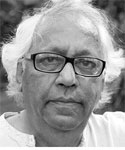
By Irfan Husain
Jul 18 2016
A few years ago, I put on a Burqa to see how it felt for an article I was writing. Beneath the mesh that almost obscured my vision, the world shrank to a narrow band; I felt hot, and my movements were restricted.
This was soon after France imposed a ban on the full Burqa that concealed the entire body and face. I concluded my column by urging that men who insisted that their wives, sisters or daughters wear this garment should try it themselves to see how it felt.
For my pains, I received a volley of abusive emails, many of them from women. Fair enough. I readily concede that what people wear is a personal decision, and neither the state nor pundits should interfere with their freedom to dress as they please.
In fact, this is an area where liberal values come in conflict with the feminist goal of liberating women from patriarchal restraints. But while the issue is often debated among liberals in the West, most of the Muslim world remains silent, accepting the Hijab, the Burqa and the Abaya as normal attire for girls and women.
If anything, the trend is towards even greater concealment of the female form. And yet I recall that when I was a kid in Karachi in the early 1950s, my mother would (shakily) mount her bicycle, and go off to her voluntary work with refugees. True, she was followed at a discreet distance by Ibrahim, the family retainer. A bit later in Lahore, my cousins would cycle to Kinnaird College without any problem.
And this social acceptance of women without Burqas was not limited to the upper-middle class: my fisherman friend Fateh at Karachi’s French Beach tells me that when he was growing up, he recalls his mother sailing on his father’s fishing boat to help pull in the nets. Of course, women working on farms can hardly encumber themselves with Burqas.
So how have these all-encompassing garments come to cover millions of girls and women across the Muslim world? After all, there is nothing in the Holy Book commanding women to conceal themselves from head to toe. While modesty in attire is enjoined for both men and women, the current vogue is relatively new.
In the sub-continent, Burqas were worn by well-born ladies in cities when they left their homes to show they did not have to work. This was more a statement of class than of religion. Most Pakistani women who migrated to the
UK from socially backward areas like Mirpur wore Dupattas, but seldom Burqas. However, many of their daughters and granddaughters, born and brought up in Britain, wear full Burqas as banners proclaiming their Muslim identity.
Nothing provokes the unspoken outrage of the most tolerant Brit than the sight of a totally concealed woman walking down the street. Apart from further separating immigrants from their hosts, the veil also prevents girls from taking part in normal school activities like athletics, swimming and theatre.
In fact, a Muslim girl in Switzerland was recently denied citizenship as she refused to meet her school requirement of swimming with her male and female classmates. In one Swiss canton, voters in a referendum agreed to impose a 9,200 euro fine on anyone wearing the full Niqab or Burqa.
Are these signs of growing Islamophobia? The short answer is yes. Given the increasing number of Muslims migrating to Europe by hook or by crook, and the heightened security concerns caused by terrorism, anti-Muslim sentiments should not surprise us.
So how did these inconvenient and unattractive garments come to cover millions of Muslim women across the world? Traditionally, it was in Afghanistan and Saudi Arabia, two of the most socially backward countries in the Muslim world, that women were obliged to cover themselves completely. These tribal garments were given religious legitimacy by local clerics. They, together with Saudi Arabia’s extremist version of Islam, were exported to other Muslim states after 1973 when the sharp spike in oil prices filled Saudi coffers.
Apart from these social and religious factors, there is a security aspect to the Burqa. When Ali Haider Gilani, the son of Pakistan’s ex-PM was kidnapped, he was apparently dressed in a Burqa while being driven to the tribal areas. Thus, the car he was in was not stopped at security checkposts along the way. What cop would risk insulting the husband or brother of a Burqa-clad lady by asking her to reveal her face?
And famously, Maulana Abdul Aziz was captured wearing a Burqa while trying to flee Islamabad’s Lal Masjid after the shootout that finally ended the siege. In many other crimes and terrorist attacks, Burqas have been used to conceal identities and weapons.
But how does a Muslim state legislate to insist that women in veils reveal their faces? Increasingly, however, Western countries are showing they will not risk the safety of citizens by permitting Muslim women to cover themselves from head to toe.
Source: thestatesman.com/mobi/news/opinion/a-veil-that-identity-wears/154833.html#B4WHD6deHqaECYDB.99




 Moderate Islamist here
Moderate Islamist here


0 comments:
Post a Comment